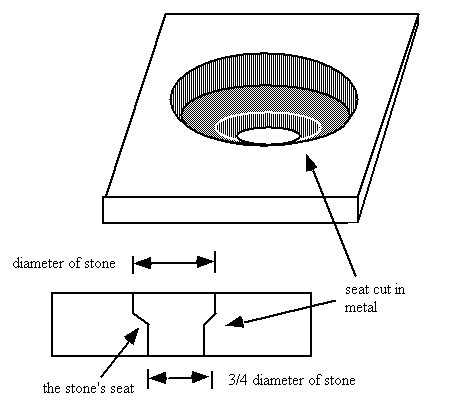Basic Gypsy or Flush Mount Setting
First the stone's diameter is measured at the pavillion and a dent is made in metal for the pilot drill (about 1mm diameter). Then the metal is drilled The metal is drilled again until the hole is about 3/4 the size of the diameter. Lubricate the drill bit. As long as there is a 0.3 mm seat left there enough to set with. It is an easy mistake not to take out enough metal, 3/4 of diameter of the stone is probably a bigger final drill bit than you think. Hold it top of the stone to see how much stone sticks out on each side of the bit.
2 Minute Read
This article is about how to do a basic gypsy or flush mount setting. See image for procedure.
Steps on How to Do Gypsy or Flush Mount Setting
- First the stone's diameter is measured at the pavillion and a dent is made in the metal for the pilot drill (about 1mm diameter). Then the metal is drilled through. The metal is drilled again until the hole is about 3/4 the size of the stone's diameter. Lubricate the drill bit. As long as there is a 0.3 mm seat left there is enough to set with. It is an easy mistake not to take out enough metal, 3/4 of the diameter of the stone is probably a bigger final drill bit than you think. Hold it on top of the stone to see how much stone sticks out on each side of the bit.
- The seat is cut to fit the stone. This is done by using a drill bit (an emergency measure only), or a stonesetting bur (which may tend to clog from removing too much material, or tip and damage the setting) or a ball bur which will stay centered no matter how one holds it and cuts easily through the material. If one desires one can cut the seat afterwards gently with the stone setting bur. Some setters use a cone or flame bur and follow it with the stonesetting bur. The tool is the same diameter as the stone.
Again, recommended procedure is first punch mark, then pilot drill, drill to 3/4 diameter of stone, use ball bur to prepare seat for stone, follow up with setting bur if desired. The cone bur can in an emergency be used to "pull" the hole in one direction or the other before using the setting bur to create the final seat. - The seat is burred down far enough that the girdle of the stone sits down 0.5mm below the surface of the metal. One measures from the top of the metal surface rather than from any burr thrown up when cutting the seat. The stone is leveled in the setting using a wooden, bras or bone tool to press it into position.
- Using a slightly blunted steel burnisher one begins by pushing down into the metal about 1.5-2mm away from the stone. One pushes down and rubs the burnisher sideways into the metal. This causes the metal to be pushed inward against the stone by the curving, thumb-like face of the burnisher. Think of pushing downwards into clay and you can see how the metal (and the inside wall of the setting) is flowed against the stone. This is repeated on the opposite side of the the stone (making sure it did not tip during setting). Then it is set N-S-E-W and all around in the same way. After the stone is set one finishes off with a point burnisher.
You assume all responsibility and risk for the use of the safety resources available on or through this web page. The International Gem Society LLC does not assume any liability for the materials, information and opinions provided on, or available through, this web page. No advice or information provided by this website shall create any warranty. Reliance on such advice, information or the content of this web page is solely at your own risk, including without limitation any safety guidelines, resources or precautions, or any other information related to safety that may be available on or through this web page. The International Gem Society LLC disclaims any liability for injury, death or damages resulting from the use thereof.
Charles Lewton-Brain
Master goldsmith Charles Lewton-Brain trained, studied and worked in Germany, Canada and the United States to learn the skills he uses. Charles Lewton-Brain is one of the original creators of Ganoksin.
The All-In-One Jewelry Making Solution At Your Fingertips
When you join the Ganoksin community, you get the tools you need to take your work to the next level.
Trusted Jewelry Making Information & Techniques
Sign up to receive the latest articles, techniques, and inspirations with our free newsletter.
